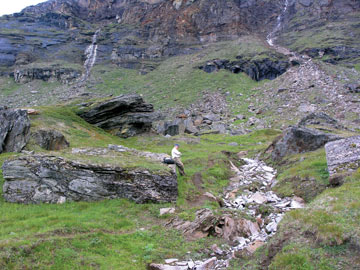|
NEWS NOTES
Pyrite carves Arctic landscape
 Courtesy of Robert Darmody |
| Researchers found that the white streaks on the cliff face in the distance at Kärkevagge in Sweden are examples of pyrite weathering, a force to be reckoned with in shaping the Swedish landscape. |
Scientists used to think that strong physical forces, such as freeze-thaw cycles, were the overwhelmingly dominant power that shaped the Arctic’s rocky landscape into majestic mountains and valleys in Lapland. A 1960 study from the Swedish valley of Kärkevagge showed, however, that chemical processes that alter the composition of rocks were the primary sculptors in that valley — but no one knew exactly how chemical weathering was altering the landscape. Now scientists have discovered the mechanism by which chemical weathering goes about its business of carving mountain sides and steep cliffs in Kärkevagge.
The black cliff faces of Kärkevagge Valley are interspersed with white streaks, which Robert Darmody of the University of Illinois at Urbana-Champaign and his colleagues determined are minerals that form as a result of pyrite oxidation. “When pyrite comes in contact with oxygen, it forms sulfuric acid and that attacks the base rocks that it is in contact with,” Darmody says. “Scientists used to think that in really cold environments like the Arctic, chemistry was unimportant, but it turned out that when this subtle process of pyrite oxidation is going on day after day, it changes the landscape more than physical weathering processes.”
Darmody and his team gathered rock samples from the valley and examined them using scanning electron microscopy and other techniques in the laboratory. The researchers, who reported their findings in the November/December GSA Bulletin, discovered that exposed pyrite was driving the chemical weathering process.
“You can see this pattern in coal mines as well,” Darmody says, adding that the same process is responsible there. By moving already oxidized overburden away, pyrite-bearing rocks are laid bare in the mines, eventually leading to acid mine drainage. “In a way, Kärkevagge is like a big natural coal mine. Only here you have glacial erosion pushing away old rocks and exposing pyrite to the air,” he says.
Pyrite oxidation is an important mechanism for weathering processes in many environments, including the Washington, D.C., subway system, Darmody says. The digging of tunnels through bedrock beneath the city many years ago unearthed pyrite-containing rocks. “Eventually the concrete that was lining the tunnels started to dissolve and it turned out that sulfuric acid had formed and was attacking the concrete,” he says.
Most pyrite-induced chemical weathering today is due to anthropogenic activities, Darmody says. “People move rocks and soil around and they dig holes and expose things that haven’t been exposed to oxygen.” This is a problem, for example, in coastal lowlands of Southeast Asia, where mangrove muds are developed for agriculture and aquaculture. These soils contain pyrite, and pumping the muds dry exposes them to air, eventually acidifying the soil, he says. “An immediate sediment and soil analysis will tell you that the pH and the chemistry look wonderful, but if you don’t measure for the sulfur content you can get in trouble down the road,” he says. “Often you’ll have only a year or two with good soil conditions and after that these areas have to be abandoned.”
Its power to acidify soil and rock makes pyrite important, Darmody says. “That’s why it is important to be aware of it.”

 Subscribe
Subscribe


